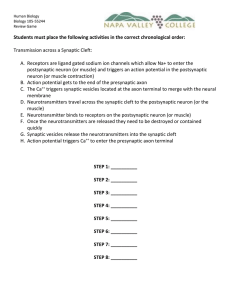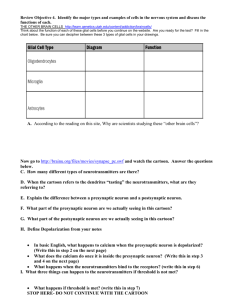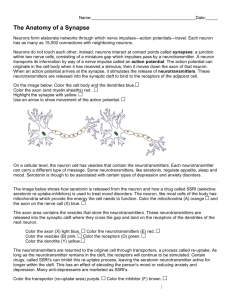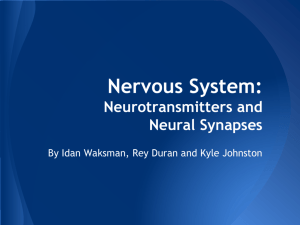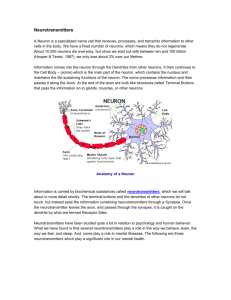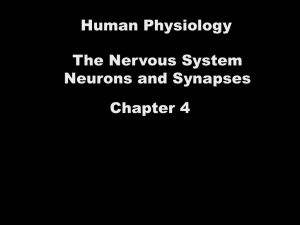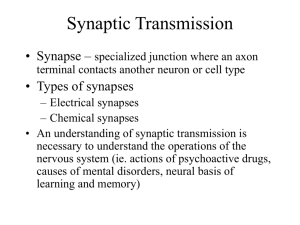The Nervous System
advertisement
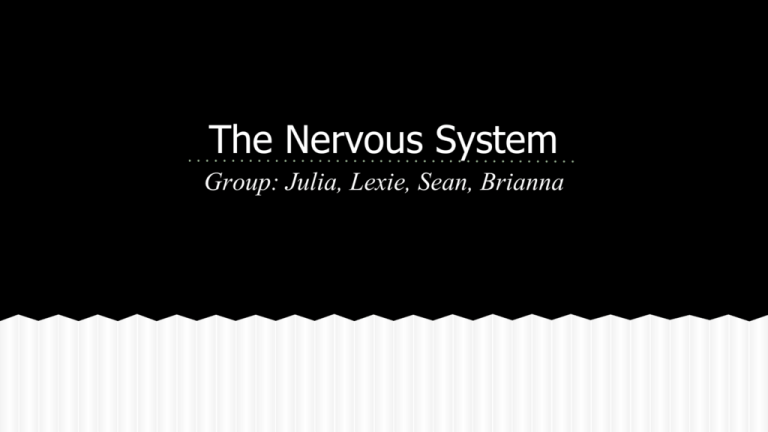
The Nervous System Group: Julia, Lexie, Sean, Brianna Remember these terms... Chemical Synapses ● ● ● ● The narrow cleft between the presynaptic cell and the postsynaptic cell Specialized junctions through which neurons signal to: o each other o non-neuronal cells (such as those in muscles or glands) Chemical synapses allow neurons to form circuits within the central nervous system. They are crucial to the biological computations that underlie perception and thought. Axon Terminal ● ● Enlarged region located at the end of a neuron’s axon Separated from the next cell by a small gap (synaptic cleft) Action Potential ● An electrical signal that is a fleeting reversal in the voltage difference across a neuron’s plasma membrane. NEW TERMS ● Presynaptic cell ● Postsynaptic cell ● Neurotransmitters How do chemical synapses work? ● When action potential reaches the axon terminal of the presynaptic cell, voltage gated calcium ion channels are opened. ● Calcium ions in these channels flow down their concentration gradient, from outside of the cell to inside the cell ● This flow induces the synaptic vesicles (containing neurotransmitters) to fuse with the plasma membrane and release the neurotransmitters from the axon terminal (via exocytosis) into the synaptic cleft. ● Note: the action potential is an electrical signal, and cannot cross the synaptic cleft for it would dissipate, so it is converted to a chemical signal in the form of neurotransmitters How do neurotransmitters work? ● After crossing the synaptic cleft, neurotransmitters bind to receptor molecules on the postsynaptic cell. This binding changes the receptors shape and creates a passageway through its interior for the neurotransmitters to enter the cell. ● The neurotransmitters, once in the cell, either stimulate the receptor cell to form a new action potential by opening a sodium channel, or inhibit the cell from forming an action potential when stimulated by another neuron ● This is what is called the excitatory and inhibitory effect. o excitatory effect: whether a neurotransmitter will help drive the postsynaptic cell to form an action potential o inhibitory effect: whether a neurotransmitter will prevent the postsynaptic cell to form an action potential Examples of Neurotransmitters ● Dopamine o Both a hormone and a neurotransmitter, acts as a NT in the brain o Diseases like Parkinson’s and Schizophrenia are associated with dysfunctions of the dopamine system o Inhibitory neurotransmitter - blocks action potentials o Strongly associated with reward mechanisms in the brain o Drugs like cocaine, nicotine, and alcohol increase dopamine levels2 Examples of Neurotransmitters ● Acetylcholine (ACh): o acts at chemical synapses between a motor neuron and muscle cell o ACh is released from the motor neuron, diffuses across the cleft, and binds to the receptors on the muscle cell membrane o In this kind of cell it has excitatory effects (trigger action potentials) which in turn initiate muscle contraction Bibliography 1. Starr, Cecie, Ralph Taggart, and Lisa Starr. Biology: The Unity and Diversity of Life. Australia: Brooks/Cole, 2001. Print. 1. Boeree, George C., Dr. "Neurotransmitters." Webspace.ship.edu. N.p., 2003. Web. 17 Nov. 2014. 1. Taylor, Tim. "Nervous System." InnerBody. InnerBody, 1999. Web. 16 Nov. 2014. 1. "What Are Neurotransmitters?" What Are Neurotransmitters? Neurogistics, 2014. Web. 15 Nov. 2014.
